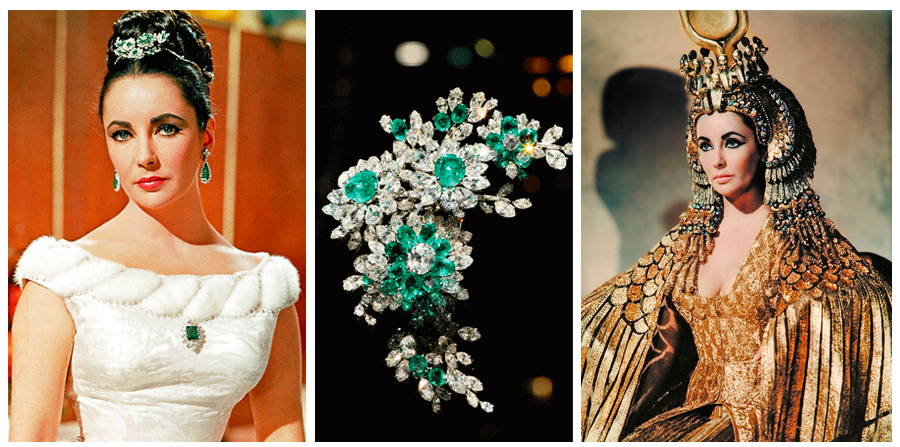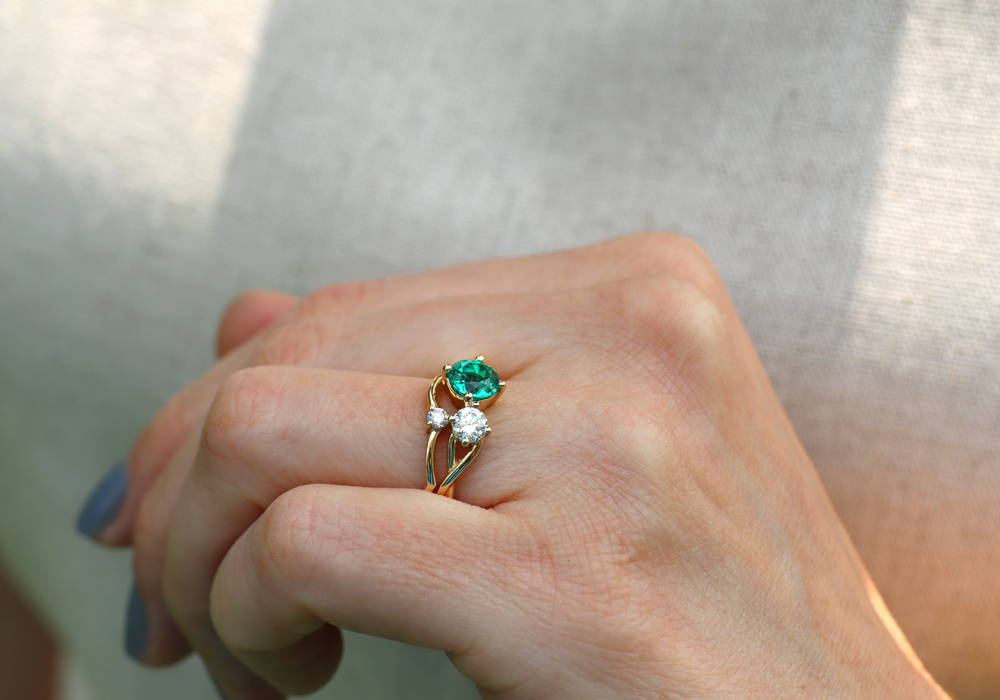
How to recognize an emerald?
Emerald , a captivating gemstone, has for centuries fascinated jewelry and mineral enthusiasts for its mesmerizing green color. This precious gem owes its distinctive luster to the presence of chromium and vanadium in its crystal structure. Emeralds are not only beautiful ornaments, they also have great cultural and historical value.
However, you should be wary since the market is saturated with counterfeits and inferior stones. The objective of this article is to help you distinguish a real emerald from its many imitations, by highlighting the criteria of color, clarity and provenance that characterize this precious stone.
What is an emerald? A gem of mineralogy
Emerald is a precious mineral that belongs to the silicate family, more precisely to the beryl group. Within mineralogy, this stone occupies a special place due to its unique characteristics and its rarity. Its brilliance and transparency make it one of the most coveted gemstones and it is often set on high-quality jewelry .
The color of emerald can vary from a pale yellowish green to a deep bluish green. Bright green is the most sought-after color in emerald, which generally makes it more expensive. In the world of mineralogy , emerald is also famous for its inclusions, called emerald gardens , which are internal formations of minerals or liquids. Although certain inclusions can decrease the value of the gem, they are also sometimes considered proof of its authenticity.
Emerald is one of the four traditional gemstones, alongside diamond, sapphire and ruby. Associated with wealth, high quality emeralds are among the most expensive in the world, especially if they are without visible inclusions. Overall, emerald's position in the gemstone world is very high, both in terms of financial value and cultural significance.
Physical properties of emerald: A unique brilliance
Emerald stands out in the world of gemstones not only for its brilliance and green color but also for its unique physical properties within silicates.
- Color : The characteristic green color can vary from very light to dark.
- Hardness : On the Mohs scale, emeralds have a hardness of 7.5 to 8, making them relatively hard but more prone to scratches than diamond, sapphire and ruby.
- Fracture : Emeralds usually have internal inclusions and cracks, making them more fragile.
- Brilliance : Emeralds have a vitreous luster .
According to followers of lithotherapy , an unscientific approach that attributes healing properties to stones and minerals, emerald has several virtues. This green gem is said to promote emotional balance, help clear the mind, and strengthen love and loyalty in a relationship. It is also believed to have the ability to improve vision, strengthen the immune system and reduce stress.
It is important to note that his beliefs are not supported by scientific evidence and that crystal healing should not replace traditional medical treatment.
Chemical properties of emerald
Emerald, a beryllium aluminum silicate, owes its color to the presence of chromium and vanadium ions. This gemstone is sensitive to sudden temperature changes and can be damaged by harsh chemicals.
Real or fake emeralds: How to tell the difference?
Emerald is a green gem that has a wide variety of inclusions called the Emerald Garden. These inclusions make each stone unique and they are not always visible to the naked eye . They are apparent when we observe them with a jeweler's loupe. The purer the emerald, the harder they are to find. On the other hand, the absence of defects or irregular patterns could mean that it is glass or crystal. Here is a series of tests that can help you recognize a real emerald.
- To the naked eye, emerald is usually dark green or blue green in color.
- Using a jeweler's loupe, view the emerald through an oblique beam of light to find inclusions.
- If the stone produces flashes of light or a rainbow, it is not an emerald.
- If the faceted edges of the stone are scratched, it is not an emerald.
- Emeralds do not have multiple layers.
- There is no such thing as “cheap” emeralds, they are one of the four precious stones along with ruby, sapphire and of course, diamond.
Synthetic or natural: Two types of emerald
The comparison between synthetic emeralds and natural emeralds attracts constant interest among gemstone enthusiasts due to their unique characteristics and distinct origins. A synthetic emerald, also known as a lab-created emerald, is produced artificially by humans while natural emeralds are formed in the earth over long periods of time.
The main difference lies in their origin. Natural emeralds arise from complex geological processes, often associated with the presence of minerals and extreme pressures in the Earth's crust. In contrast, synthetic emeralds are manufactured under high pressure and high temperature (HPHT) by recreating these conditions in the laboratory. Current techniques also make it possible to reproduce inclusions.
Ultimately, the choice between a synthetic emerald and a natural emerald comes down to personal preference and budgetary considerations since the two share similarities in chemical composition and appearance. Synthetic emeralds often offer a lower cost while natural emeralds are prized for their rarity and provenance. The damage caused by mining can also influence the choice of a person concerned about environmental issues.
The value of an emerald: A valuable investment
The value of an emerald is determined by several key factors that play a crucial role in its appreciation in the jewelry and jewelry market. These factors are essential for collectors' investment in the gemstone business.
Like the diamond, the emerald is evaluated according to 4 criteria: color, clarity, cut (size) and carat (weight). Generally, a bright, transparent emerald with a few visible inclusions will have a greater value than a blurred emerald whose inclusions are small and numerous.
Color quality is essential. The green hue of an emerald must be intense, uniform and pleasing to the eye to be of great value. Real emeralds are dichroic. They appear blue-green from one angle and slightly yellow-green from the other. The stronger the dichroism with two distinct colors, the higher the quality of the emerald.
The transparency of the stone is another crucial element. The fewer inclusions or imperfections visible to the naked eye, the more valuable the emerald.
Size and weight are also important. Large, well-cut emeralds have a higher value, especially when used in jewelry such as necklaces.
Finally, the origin of the emerald can also influence its market value . Emeralds from regions known for their quality, such as Colombia, may be more prized in the market.
-
EMERALD QUALITY
BAD
Blurred shine, lots of bubbles
and small incursions.
AVERAGE
Slightly blurred shine, numerous and visible incursions.
GOOD
Bright shine, incursions and bubbles
visible in small groups.
HIGH
Very bright shine, very light incursions and almost no bubbles.
The origin of emeralds
The first emeralds were discovered in the mines of Egypt 3,500 years BC, becoming over time a symbol of Egyptian national pride. When she took power in 47 BC, Queen Cleopatra, the last pharaoh of Egypt, seized all the country's deposits in order to maintain control over this magnificent green stone that she loved most that all. Funny fact, the American actress Elizabeth Taylor who played Cleopatra in the cinema in 1963 has a large collection of emerald jewelry which goes wonderfully well with her green eyes.

The deposits of the world
Egypt's emerald deposits have long been exhausted. Today, high-quality emeralds mainly come from deposits in Colombia and Zambia. Colombian emeralds are particularly recognized for their vibrant green and purity. There are also deposits in Afghanistan, Brazil, Madagascar, Pakistan, Russia and Zimbabwe.
To deepen your knowledge of emerald, its unique properties and its origins, the “ Fascinating emerald ” workshop is offered by iGEM, the Montreal Gemmology Institute.
The emerald, a jewel to recognize
To identify a real emerald from its imitations, you must focus on the color and clarity criteria that characterize this precious stone. Its color can vary from pale yellowish green to deep bluish green, but bright green is the most sought after. If the stone produces flashes of light or a rainbow when viewed through a beam of light, it is not an emerald. The inclusions or gardens of the emerald are not always visible to the naked eye but they guarantee its authenticity. Consult us for an exact valuation of your gemstone. Our expertise with gems guarantees you peace of mind.
FAQ – Frequently Asked Questions
1. How to recognize an emerald?
Recognizing a real emerald can be a challenge since there are many imitations on the market. Genuine emeralds have a deep, intense green color that often has internal inclusions invisible to the naked eye. They have a glassy shine without shining like a diamond. They are relatively hard but can be scratched. High quality emeralds are expensive. If the price seems too low, there's a good chance the stone is counterfeit.
2. What is the price of a natural emerald vs. a synthetic emerald?
The price of a natural emerald varies greatly depending on several factors, including the quality of the stone, its origin and its rarity. High quality natural emeralds can be very expensive, reaching thousands or even tens of thousands of dollars per carat and even more for exceptional gems. On the other hand, synthetic or laboratory-created emeralds are less expensive than their natural counterparts. Their cost depends on the quality of manufacturing, size and other features but they are significantly more affordable. High-quality synthetic emeralds can still cost several hundred dollars per carat.
3. Is lab-created emerald real emerald?
Yes. Lab-created emerald is real emerald, but it is produced by humans by recreating the geological conditions under which natural emeralds form in nature. Synthetic emerald has the same chemical composition and physical properties as natural emerald but is artificial in relation to its geological origin.
4. What is the meaning of an emerald engagement ring?
Less common than the diamond engagement ring, the emerald engagement ring symbolizes eternal love, hope, renewal, wisdom, patience, balance and mutual support in individual and marital development. It is important to note that the meaning of an emerald engagement ring can vary depending on culture and personal beliefs. Some choose this gemstone simply for its beauty and uniqueness.
Still have questions? We can help you.
Get an online consultation with one of our jewelers today.




